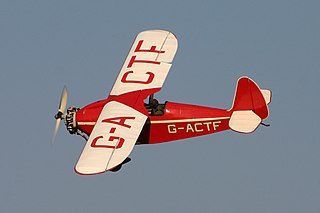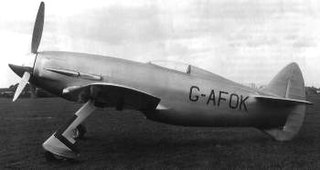Related Research Articles

Leslie Everett Baynes, AFRAeS was an English aeronautical engineer.

The Boulton Paul P.92 was a British design by Boulton Paul for a two-seat, turret-armed, twin-engine heavy fighter and ground attack aircraft to meet Air Ministry Specification F.11/37. Only a half scale prototype – the P.92/2 – was built and tested as check on aerodynamics before the project was cancelled in 1940.
The Arpin A-1 was a two-seat low-wing monoplane which was powered by a single radial engine in pusher configuration, mounted behind the cabin between twin booms that carried the tail. An unconventional fixed tricycle undercarriage was fitted. Only one was built.

The Royal Aircraft Factory F.E.8 was a British single-seat fighter of the First World War designed at the Royal Aircraft Factory. It could not escape the drag penalty imposed by its tail structure and was no match for the Albatros fighters of late 1916.

The Comper C.L.A.7 Swift is a British 1930s single-seat sporting aircraft produced by Comper Aircraft Company Ltd of Hooton Park, Cheshire.

The Heston Type 1 Phoenix was a 1930s British single-engined five-seat light transport monoplane built by the Heston Aircraft Company Limited.

The Napier-Heston Racer, also referred to as the Heston Type 5 Racer or Heston High Speed Aircraft J.5, was a 1940s British single-seat racing monoplane first conceived by D. Napier and Son Ltd., and built by the Heston Aircraft Company Ltd, for an attempt on the World Air Speed Record. The private venture was financed by William Morris, Lord Nuffield.

The Heston JC.6 was a British prototype air observation post aircraft designed and built by the Heston Aircraft Company Limited, who had previously built the Heston Phoenix, the Heston T.1/37 and the Napier-Heston Racer. The JC.6 was also known as the Heston A.2/45 or the Heston AOP.

The Comper Mouse was a 1930s British three-seat cabin monoplane designed by Nicholas Comper, and built by the Comper Aircraft Company at Heston Aerodrome in 1933.
The Comper Aircraft Company Ltd was a 1930s British light aircraft manufacturer. It was based at Hooton Aerodrome, Cheshire (1929-1933), and Heston Aerodrome, Middlesex (1933-1934).
Nicholas Comper was an English aviator and aircraft designer, whose most notable success was the 1930s Comper Swift monoplane racer.
Heston Aircraft Company was a British aircraft manufacturer based at Heston Aerodrome, Middlesex, England.

The Heston T.1/37 was a 1930s British single-engined monoplane military trainer aircraft with two open cockpits, designed and developed by Heston Aircraft Company Ltd. It was not accepted for service.

The Hordern-Richmond Autoplane was a 1930s British twin engined two seat cabin touring monoplane designed by Edmund Hordern, and constructed by Heston Aircraft Company Ltd.

The Stout Skycar was a series of four one-off American light aircraft of the 1930s.
The Fane Aircraft Company Limited was a British company formed by the aviator Captain Gerard Fane, DSC, and based at Norbury, London, England.

The Comper Streak was a single-engined, single-seat racing monoplane built in the UK in the mid-1930s. It was not successful as a racer and only one was produced.
The Comper Kite was a single-engined, two-seat touring monoplane built in the UK, derived from the contemporary Comper Streak racer. Only one was built.

The Vickers F.B.25 was a British two-seat night fighter prototype of World War I designed to attack enemy airships. Completed in 1917, it failed in its official flight tests that year and no order for production resulted.

The ASL Valkyrie was a canard pusher configuration aircraft designed by the Aeronautical Syndicate Ltd in 1910. Examples were widely flown during 1911 and were used for instructional purposes at the ASL flying school, which was the first occupant of Hendon Aerodrome in London.
References
- Jackson, A.J. (1973). British Civil Aircraft since 1919 Volume 2. London: Putnam. p. 382. ISBN 0-370-10010-7.
- Meaden, Jack (Autumn 2005). "The Whole Truth: The Comper Lightplanes: Part Eight – The Comper Scamp and its Developments". Air-Britain Archive. pp. 93–96. ISSN 0262-4923.